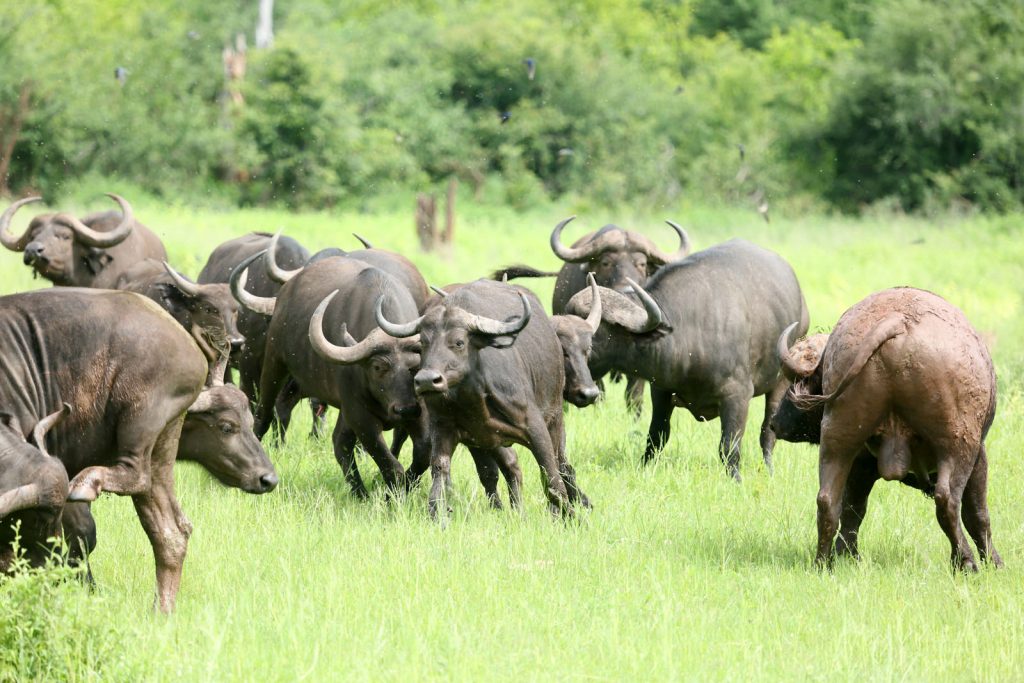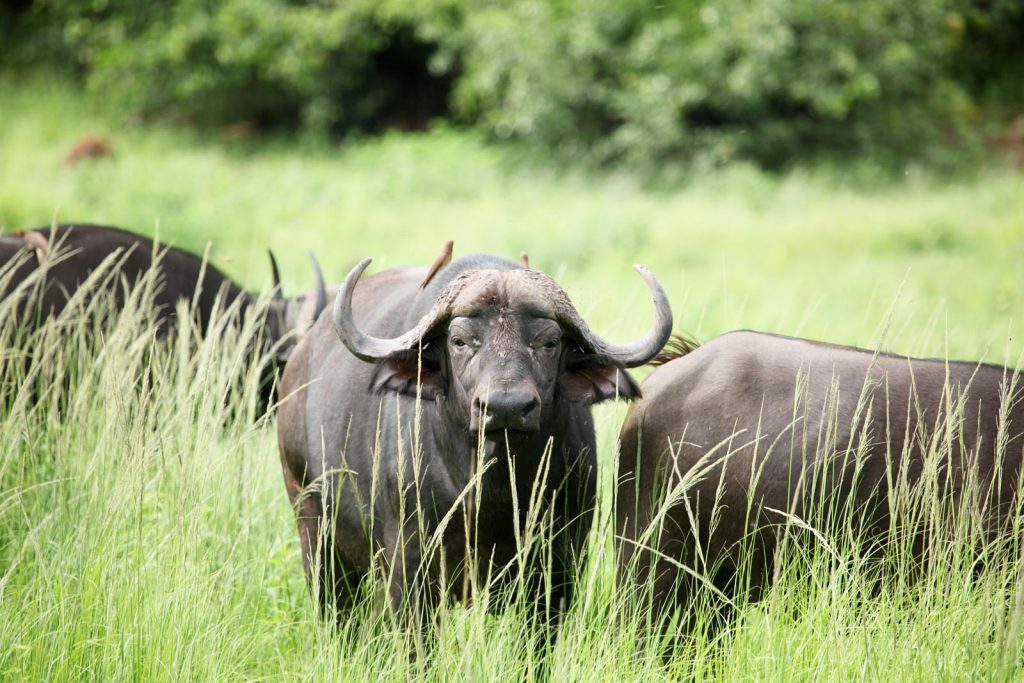- Our Story
About us
Bush blog
- Safaris
- Camps & Lodges
- Destinations
- Specials
- Our Foundation
- Get in Touch
Contact
International +27 21 701 0270 UK +0800 0418 187 US +1(888) 3441126 contact@africanbushcamps.comTalk to a Safari Expert
BOOK A CALL
The African buffalo is one of Africa’s “big five” animals, along with lions, leopards, rhinos, and elephants. Both male and female buffalos have big, sharp horns. They have great eyesight, hearing, and smell, mainly to spot lions, their main threat. Because of their strong eyesight, they often eat at night, and in some places, they’re active only at night.
We’ve listed everything you need to know about the African Buffalo in Southern Africa
Buffalos, like many animals, have their own unique ways of communicating, primarily relying on body language and specific postures to convey messages. Their interactions, especially among males, are a series of choreographed rituals that establish or affirm dominance.
For instance, when a male buffalo wants to showcase his dominance or threaten another, he adopts a very specific stance. He lifts his head high, giving him an imposing presence, while simultaneously lowering his muzzle. In response, a submissive male buffalo acknowledges this dominance in a rather unique and humble manner. Approaching with his head lowered, the submissive male places his muzzle between the dominant bull’s hind legs and lets out a deep, resonant bellow. This action signifies respect and submission to the dominant buffalo.

Despite these displays of power and submission, buffalos are generally not very vocal creatures. Their day-to-day communications are subtle, often limited to sporadic grunts or snorts, echoing their calm demeanor.
However, when night falls, buffalos exhibit a remarkable tactic to ensure their safety. Should they sense danger, the entire herd adopts an eerily effective warning system. Every individual in the herd becomes utterly silent, almost blending into the obscurity of the night. This collective silence makes it difficult for predators to pinpoint individual buffalos, offering them a unique protection mechanism in the cover of darkness.
Buffalos have a structured daily routine, primarily centered around their dietary needs. Their day is marked by phases of grazing, where they feed on grass, followed by ruminating, a process in which they chew the cud, aiding in the digestion of the food they’ve consumed. The distances buffalos travel during their grazing sessions can vary widely. While certain herds are content with staying relatively close to their resting spots, others are more nomadic in nature. Some of these more restless herds can cover impressive distances, walking up to five miles (8 km) in just a single day.

In addition to their feeding habits, buffalos have a particular fondness for wallowing in mud. This muddy pastime isn’t just for pleasure; it serves a practical purpose. The layer of mud acts as a protective barrier, discouraging pesky insects from biting them.
Buffalo social dynamics offer interesting observations. Calves, or the young ones, usually prefer a more solitary existence and seldom indulge in playful interactions with their peers. In contrast, adult bulls showcase a different side of their behavior. They engage in sparring matches, locking and pushing against each other’s horns in displays of strength and skill. These tussles can be perceived as tests of dominance, especially prevalent among the males in larger herds with intricate social hierarchies. Interestingly, these sparring sessions seem to be enjoyed by both participants, regardless of who emerges as the dominant figure.
However, it’s essential to distinguish between these playful spars and genuine fights. Real confrontations between buffalos are infrequent, but when they occur, they can be intense and brutal. Such battles carry high stakes, as they can result in severe injuries or even the death of one or both of the contenders.
Buffalo populations are under significant threat due to a combination of factors, with habitat destruction being at the forefront. Overgrazing by livestock is a prime reason for such destruction, as it results in the degradation of the natural environment that buffalos call home. Another looming threat is disease, particularly rinderpest. This highly contagious ailment primarily affects cattle but can easily jump to buffalos, rendering them incredibly vulnerable.
A common misconception among many farmers further exacerbates the situation. They often mistakenly attribute the spread of rinderpest to buffalos, which leads to a misguided notion that eliminating buffalos can safeguard their cattle. This misplaced blame has led to unwarranted pressures to cull buffalo populations, endangering their existence further.

Infrastructure development, especially the construction of roads, has also had a detrimental impact on buffalo populations. Roads fragment their habitats, leading to isolated herds that struggle to maintain their numbers. Moreover, roads can inadvertently facilitate poaching by providing easier access to remote buffalo territories. Poachers are drawn to these animals due to their reputation as one of Africa’s most dangerous beasts, which paradoxically makes them even more appealing as hunting trophies. The allure of possessing such a trophy, emblematic of power and danger, means that buffalos are continually at risk from those seeking to exploit their majestic stature for personal gain.
The Social Structure of the African Buffalo
Buffalo herds exhibit fascinating dynamics in terms of size and structure. These herds can range from a modest group of 20 to a massive gathering of over 1,000 animals. Remarkably, a single herd can persist for more than half a century, witnessing the rise and fall of numerous buffalo generations.
These large assemblies of buffalos aren’t static. Large herds have tendencies to fracture into smaller groups for certain periods, only to reconvene later. Similarly, distinct herds might cross paths and temporarily intermingle, adding to the dynamic nature of their existence.
Females display a sense of loyalty to their birth herd. They not only remain in the herd of their birth but also ensure that their offspring continue the tradition, staying alongside them deep into their mature years. On the other hand, adult male buffalos have a more nomadic nature. They often leave the family herd to either align with groups of other males or oscillate between a lone-wolf lifestyle and rejoining the primary group. Interestingly, some males demonstrate a sense of strategy, collaborating with fellow bulls to decide the opportune moment to reintegrate into a herd.
Buffalos aren’t merely wandering aimlessly within these groups. They adhere to a specific hierarchy and position, be it at the rear, smack in the middle, or leading at the front. The decision-making process in terms of migration is an inclusive one. Adult females utilize a sort of democratic process to navigate the herd’s direction. They effectively “vote” on the direction by aligning their heads towards their preferred path. The majority’s inclination then sets the course.
Further adding to the herd’s organizational structure are the “lead animals.” These could be either mature males or females. They assume the responsibility of leading the pack, setting the pace, and signaling when it’s time for a rest.